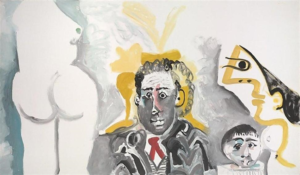Bloomberg is reporting today on a money laundering scam originating in London involving Matthew Green, scion of one of the most vaunted names in the art trade. Simply, it involved Green providing a painting to be purchased from an anonymous seller using dirty money- in this case a late work by Picasso- which Green would then resell in the retail art market, netting himself, presumably, a nice commission, and the remaining proceeds, clean now, remit to shady characters behind the scene.
In the trade, this kind of scam is an old, old story- art or antiques purchased abroad for cash, then brought duty free to this country and sold legitimately. Easy peasy, and very, very difficult to stop. For ourselves, we have witnessed what we concluded was an influx of dirty money with dealers whose inordinate expansion and acquisition of stock seemed out of reasonable proportion to their sales. At a certain level, the trade involves a relatively small number of players, and it is hard for a dealer to keep his activity entirely to himself. Most of us deal with the same small pool of clients, and while clients do prefer to trade with only a few dealers, there is enough shall we say crossover that one invariably finds out about significant private purchases.
And of course, too, there is and has been for centuries a thriving gray market in art and antiques from which underworld types and dealers who are of a mind might, shall we say, ‘source’ items for cash for resale in the open market. With yet untold thousands of works looted by the Nazis still floating around unaccounted for, there are still plenty of pieces to acquire. The underworld appreciates the inherent value, and indeed the cachet of utilizing fine art as both a vector for money laundering and as a crypto currency. Donna Tartt’s novel of a few years ago, The Goldfinch, centered around a Dutch old master painting that was used as surety by mob types. And I’ve heard it suggested that the paintings stolen from the Gardner Museum are thought to be now in use in the same manner.
While I wouldn’t say the trade is any less honest than any other business, it is rather more secretive and this might make it easier for its infiltration by those who seek to launder cash. Even in the most straightforward sales, buyers and sellers wish to remain private. While we do hear about some of the larger sales at auction- witness the purchase of the crypto da Vinci- in the main, the well-heeled like to keep their wealth away from prying eyes.
Matthew Green has now sadly joined nefarious company with Knoedler, Berry Hill Galleries, Salander-O’Reilly, and Mallett. One might presume that it is the nature of the trade, but something to note- these are dealers whose business in London and New York is very, very expensive to pay for. Another feature, dealers sometimes fall into the trap of wanting to maintain a lifestyle akin to that of their clients, and once geared up, when the money stops flowing, find themselves backed into doing things they might not otherwise. Mind you, I’ve cited some high profile bad apples, but the trade internationally constitutes a small-ish barrel. But before my gentle readers believe that the auction houses are the place to trade, I would point out that they are not precisely bastions of probity, either. The huge commission price fixing scandal involving Christie’s and Sotheby’s is not yet ancient history.

